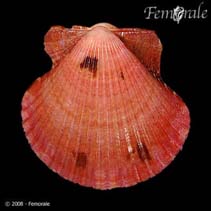| Family: |
Pectinidae (scallops) |
| Max. size: |
10 cm SHL (male/unsexed) |
| Environment: |
benthic; brackish; marine; depth range 0 - 180 m |
| Distribution: |
Eastern Pacific: From California, USA (35°N) and the Gulf of California to Piura, Peru (6°S). |
| Diagnosis: |
|
| Biology: |
Inhabits shallow bays, sloughs and calm offshore areas; often associated with eelgrass beds. Moves by expelling water between valves propelling to a distance of 1m upwards or several meters sideways, i.e., flying motion. Smaller scallops are generally attached to the substrate by byssal threads (Ref. 78081). Commercial scallop fishery in early 1900s overexploited this resource, the fishery fell in the 1950s and the once abundant scallop became rare along the northern range of its distribution. This led to the protection of this species by the California Fish and Game Commission in 1954 (Ref. 78082). Commercial scallop fisheries and aquaculture exist in Baja California Sur, Mexico both on Pacific and Gulf of California areas since the 1980s (Ref. 78088) with peak catches at Magdalena Bay in 1990 accounting for 53% of total Mexican scallop production (Ref. 78090). |
| IUCN Red List Status: |
Not Evaluated (N.E.) Ref. 123251)
|
| Threat to humans: |
harmless |
| Country info: |
|
Source and more info: www.sealifebase.org. For personal, classroom, and other internal use only. Not for publication.

